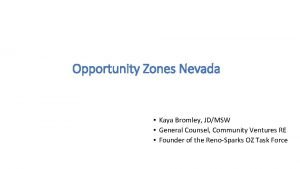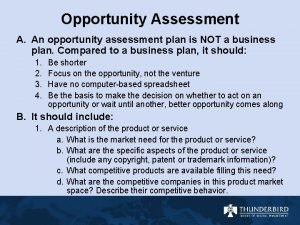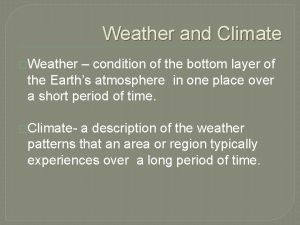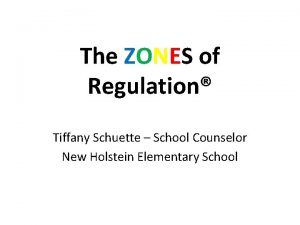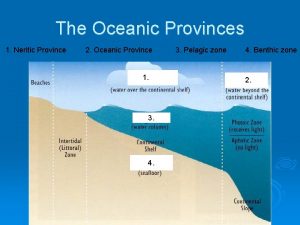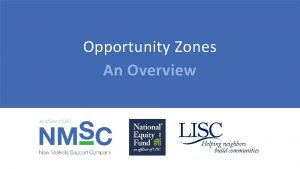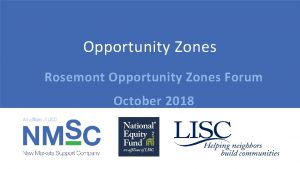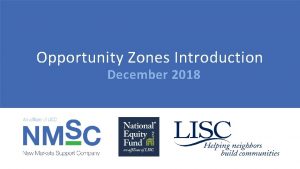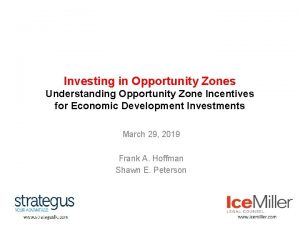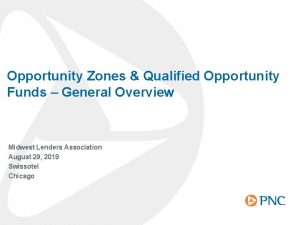INTRODUCTION TO OPPORTUNITY ZONES NARC CONFERENCE Washington DC
















- Slides: 16

INTRODUCTION TO OPPORTUNITY ZONES NARC CONFERENCE Washington, DC February 11, 2019

What are Opportunity Zones? The Opportunity Zone tax incentive is a bipartisan initiative to spur long-term private investment in low-income urban and rural communities, established by Congress in the 2017 Tax Cuts and Jobs Act. U. S. investors currently hold $2. 3 trillion in unrealized capital gains, representing a significant untapped resource for economic development.

OPPORTUNITY Why now? OPPORTUNITY ZONES More than half of America’s most economically distressed communities contained both fewer jobs and businesses in 2015 than they did in 2000. New business formation is near a record low. The average distressed community saw a 6 percent decline in local businesses during the prime years of the national economic recovery. The U. S. economy is increasingly dependent on a handful of places for growth. Five metro areas produced as many new businesses as the rest of the country combined from 2010 – 2014. Data from the Economic Innovation Group. Read more at eig. org/opportunityzones Now is the time to diversify. ZONES

What are Opportunity Zones? Opportunity Zone: A low-income census tract (< 80% of area median income OR a poverty rate of greater than 20%) that has been designated by the governor of the state or territory in which it is located and approved by the U. S. Treasury Department. Designations will stay in place for 10 years. Up to 25% of LICs in a U. S. state or territory may be designated as OZs. States or territories in which there are fewer than 100 LICs may designate up to 25 LICs as OZs. Up to 5% of census tracts contiguous to LICs may be designated as OZs, if the median family income of the census tract does not exceed 125% of the median family income of the LIC to which the tract is contiguous.

Designated Opportunity Zones – National Stats 8, 762 census tracts designated 24 million current jobs in designated tracts 1. 6 million businesses in designated tracts Average poverty rate 31% Average unemployment rate 14. 4% Average family income in OZ census tracts relative to area median income (AMI) 60%

Opportunity Funds Opportunity Fund: An investment vehicle organized as a corporation or partnership for the purpose of investing in Opportunity Zone property. Opportunity Funds will be self-certified per IRS guidelines. They must be organized for the purpose of investing in Opportunity Zones Opportunity Funds are required to invest 90% or more of their capital as EQUITY in Opportunity Zone property Investors receive a return on their investment through a seven-year stream of tax credits (totaling 39%). Opportunity Zone property includes stock, partnership interest, or business property in an Opportunity Zone

OPPORTUNITY ZONES Investor Incentives Cancellation of taxes Reduction of taxes Deferral of taxes On capital gains invested in Qualified Opportunity Zone Funds On investments held in Qualified Opportunity Zone Funds 5+ years On new gains made through Qualified Opportunity Zone Fund investments held 10+ years

Timeline for Opportunity Zone Investments Investment Year 2019 Tax on Capital Gain Invested Gain realized and invested in Opportunity Fund within 180 days* Year 5 2024 10% reduction of capital gains tax Year 7 Year 8 2026 15% reduction of capital gains tax All taxes due on 12/31/26. Investor pays tax on 85% of original gain Year 10 2029 * Tax is deferred until the earlier of investment liquidation (return of capital) or 12/31/26 Tax on Opportunity Fund Investment Any gain realized on Opportunity Fund investment is fully taxable if liquidated Any gain realized on Opportunity Fund investment is tax free** ** Any appreciation on Opportunity Fund investment is tax free if held > 10 years

Ex. 10 Year Investment: Fully Taxable vs. Opportunity Zone Fund Assumptions: • 10% annual investment appreciation • 24% capital gains tax (federal only) Fully Taxed Investment Capital Gain Opportunity Zone Investment $100, 000 Capital Gain - Tax payable (24%) $24, 000 - Tax payable Total Capital to Invest $76, 000 Total Capital to Invest $100, 000 Sales Price after 10 years $259, 374 Sales Price after 10 years - Tax on Appreciation (24%) After Tax Funds Available $197, 000 $29, 070 $168, 054 - Tax on Appreciation $100, 000 $0 $0 Deferred Capital Gain Tax (24%) paid in 2026 $20, 480 After Tax Funds Available $238, 974

Economic Development Examples 1 Business infrastructure real estate funds: • Industrial • Retail • Mixed use • TOD 2 Venture capital funds: • Seed stage investments • Series A investments 3 Operating business private equity: • Businesses moving or expanding into an Opportunity Zone • Equipment financing 4 Enhancement for other federal tax credit transactions: • NMTCs • Historic Tax Credits

Affordable Housing Examples 1 Pairing with LIHTC or the HTC • Yield boost for tax credit investments providing housing for families at or under 60% AMI • 10 -15 year investment period • Investors = corporate investors with capital gains to invest and tax credit appetite 2 Workforce Rental Housing 3 Lease-to-own Housing • Providing housing for families at • Single family or multi-family 80 – 120% AMI • New construction or rehab • 10 year investment period • Investors = social impact focus • Investors = individuals or corporations 11

Strengths Local Designations are made by states and localities, rather than Federal agencies, ensuring more local buy in and coordination Flexible New Investor Class The flexibility of the investment tool can support investments in any type of asset class The incentive has the ability to attract high net worth individual investors to community development finance Potential Straightforward The incentive could attract hundreds of billions of private sector capital into low-income communities The tool is relatively straightforward from an investment and compliance standpoint, in comparison to LIHTC and NMTC

Concerns Lack of Oversight Lack of oversight from government entities could lead to program abuses Lack of Impact Incentives Gentrification and Displacement Future of Other Tax Incentives focus on back-end returns, rather than investments that will result in community impacts The tool might aid in the gentrification and displacement of residents and businesses in Opportunity Zone communities The new incentive might be used as an excuse to diminish or eliminate other community development tax incentives, such as the NMTC program

OPPORTUNITY ZONES Key Regulatory Issues Addressed • IRS published proposed regulations in November of 2018 that can be relied upon by taxpayers seeking to make O-Zone investments. Of note, the regulations clarify that: • Investment funds must come from capital gains • 70% of the QOZB assets must be located in the O-Zone • 50% of the gross income must be from activities in the O-Zone • O-Funds have some flexibility to align compliance periods around receipt of funds • QOZBs have up to 31 months to fully deploy invested capital into qualified assets • Land costs are excluded from the requirement that an O-Fund must invest at least double the basis of a real estate project within 30 months.

OPPORTUNITY ZONES Key Regulatory Issues Remaining • Critical regulatory clarifications or additional guidance is still needed on several issues, including: • Whether “active conduct of a trade or business” includes the rental of real property • The requirement that 50% of income must be derived from activities in the Opportunity Zone • Whether minimal level of investment will be required when all or a significant portion of the value of the QOZP is the land • What constitutes the “original use” of a property? • The extent to which O-Funds can redeploy returned investment capital within the 10 year period without triggering a tax event • O-Fund reporting requirements (both for compliance and for evaluation purposes)

Contact Information Matt Josephs 202 -739 -9264 Senior VP mjosephs@lisc. org LISC Policy
 Weather and climate video
Weather and climate video How do littoral zones differ from riparian zones?
How do littoral zones differ from riparian zones? Asheville opportunity zones
Asheville opportunity zones Nevada opportunity zones
Nevada opportunity zones Opportunity assessment plan sample
Opportunity assessment plan sample Novogradac opportunity zone conference
Novogradac opportunity zone conference Washington naval conference definition
Washington naval conference definition Hardiness zones asia
Hardiness zones asia Unit 2: the united states and canada worksheet answers
Unit 2: the united states and canada worksheet answers Different zones of the earth
Different zones of the earth Natural vegetation regions
Natural vegetation regions Zones of regulation
Zones of regulation State plane coordinate system
State plane coordinate system Mexico climate zones
Mexico climate zones Neritic province and oceanic province
Neritic province and oceanic province Hachetfish
Hachetfish Midnight zone
Midnight zone



